Cricket fans want instant access to match updates, scores, and player information in this digital age. An effective approach to incorporate real-time cricket data into your website and keep your audience informed is by using a Cricket Live Line API, also known as a Cricket API for Live Line. The context for comprehending the operation of these APIs and their importance in improving the user experience on cricket websites is provided by this introduction.
Understanding Cricket Live Line APIs
In essence, a cricket live line API is a technology that allows your website or app to get real-time cricket data directly into it, including player statistics, live scores, and match commentary. By serving as a link between your platform and the data supplier, this API enables you to provide a rich user experience without the need for intricate backend infrastructure. It is especially helpful for live sports event coverage websites since it provides rapid and accurate updates to the viewers.
Key aspects:
Real-Time Data: The API ensures that users receive updates in real time, which is crucial for live sports coverage.
Comprehensive Coverage: APIs typically offer data across various formats, including T20, ODI, and Test matches.
Seamless Integration: These APIs are designed to be easy to integrate with existing websites, providing a straightforward way to enhance functionality.
Benefits of Integrating Cricket API for Live Line
Numerous advantages come with integrating a Cricket API for Live Line, which can greatly improve the functionality and attractiveness of your cricket website.
1. Real-Time Updates:** The primary benefit of integrating a Cricket Live Line API is the ability to deliver real-time updates. Fans can track live scores, follow ball-by-ball commentary, and stay updated on match progress as it happens. This immediacy keeps users engaged and encourages them to return to your site during future games.
2. Enhanced User Engagement:** When users have access to the latest information, they are more likely to spend more time on your website. Features like live scoreboards, real-time player stats, and interactive match centers can make your site more engaging, leading to higher user retention and satisfaction.
3. Comprehensive Data Coverage:** A robust Cricket API for Live Line provides comprehensive data, including not just scores and commentary, but also player profiles, team statistics, historical match data, and much more. This breadth of information can attract a wider audience, from casual fans to serious analysts.
4. Customization Options:** These APIs offer customization options that allow you to tailor the data presentation to match your site’s design and user interface. You can choose which data to display and how it should be formatted, ensuring a seamless integration with your existing content.
How to Choose the Right Cricket Live Line API
Selecting the right Cricket Live Line API is crucial for ensuring that your website functions smoothly and provides a great user experience.
1. Accuracy and Speed of Data: Two important aspects are the accuracy and speed of data updates. To guarantee that your consumers receive the most recent information, look for an API that offers extremely accurate data with low latency.
2. Ease of Integration: Even if you lack substantial technical knowledge, integrating the API into your website should be simple. Good customer support, SDKs, and documentation are signs of an API that will be easy to use.
3. Flexibility in Customization: Customization is essential to guaranteeing that the API data blends in perfectly with the look and feel of your website. The finest APIs give you freedom in the data presentation and let you select which data to show.
4. Cost-Effectiveness: Although it may be tempting to choose the API with the greatest features, it's crucial to strike a balance between functionality and price. Select an API that provides the best value for the functionality you require while keeping an eye on your budget.
Step-by-Step Integration Process
Integrating a Cricket Live Line API into your website involves several key steps:
1. Choose the API Provider: Start by doing your homework and deciding on a reputable API provider that can fulfill your requirements. Think about things like price, update speed, and data coverage.
2. Register and Get API credentials: After deciding on a provider, register for the service and get your API credentials. In order to authenticate your API queries, you must have these keys.
3. Examine Documentation: Go over the service's API documentation with great care. You will be guided through the process of submitting requests to the API and managing the answers by this documentation.
4. Put the API into Practice: Begin incorporating the API into your website using the documentation and API keys. To retrieve and show the data, you might need to create some code, depending on your platform (WordPress, custom HTML, etc.).
5. Test the Integration: After the API has been implemented, make sure everything functions as it should by giving it a comprehensive test. Verify the accurate display of the data, the latest updates in real time, and any possible mistakes.
6. Optimize for Performance: Make sure the data is handled effectively by your website. This may include tweaking your code for better performance or caching data to shorten load times.

Enhancing User Experience with Custom Features
After the Cricket Live Line API has been successfully connected, you may add unique features to improve the customer experience even more:
1. Live Score Widgets: Add live score widgets to pages that are particular to a match or your homepage. Users don't have to refresh the page to stay engaged because these widgets offer changes at a look.
2. Player Profiles: Make thorough player profiles with current results, career history, and statistics. Users who want a deeper analysis may be drawn in by this feature.
3. Interactive Match Center: The third suggestion is to create an interactive match center where people can track the game in real time. This can contain scorecards, ball-by-ball commentary, and even graphic depictions of the game (like pitch maps).
4. Push Notifications: Set up push alerts for important occasions like wickets, anniversaries, or game outcomes. Even when they are not actively using your website, this informs users.
Common Challenges and How to Overcome Them
The challenges of integrating a Cricket API for Live Line can be unique. Here's how to handle a few such problems:
1. API Downtime:No API is immune to downtime. Ensure your provider offers high availability and have a fallback plan in case of outages, such as displaying cached data or a message to users.
2. Data Latency: Some APIs might have a delay in data updates, which can frustrate users. Choose an API known for minimal latency, and consider implementing caching strategies to reduce the impact of any delays.
3. Integration Issues: Integration issues can arise, especially if your website has a complex setup. Rely on the API provider’s documentation and support, and don’t hesitate to reach out to their customer service if you encounter problems.
Conclusion
Integrating a Cricket Live Line API into your website is a powerful way to enhance user engagement by providing real-time cricket updates. By carefully selecting the right API, following best practices for integration, and adding custom features, you can transform your cricket website into a go-to destination for fans. The right API solution not only improves the user experience but also helps in building a loyal audience who will keep coming back for accurate, timely cricket information.









